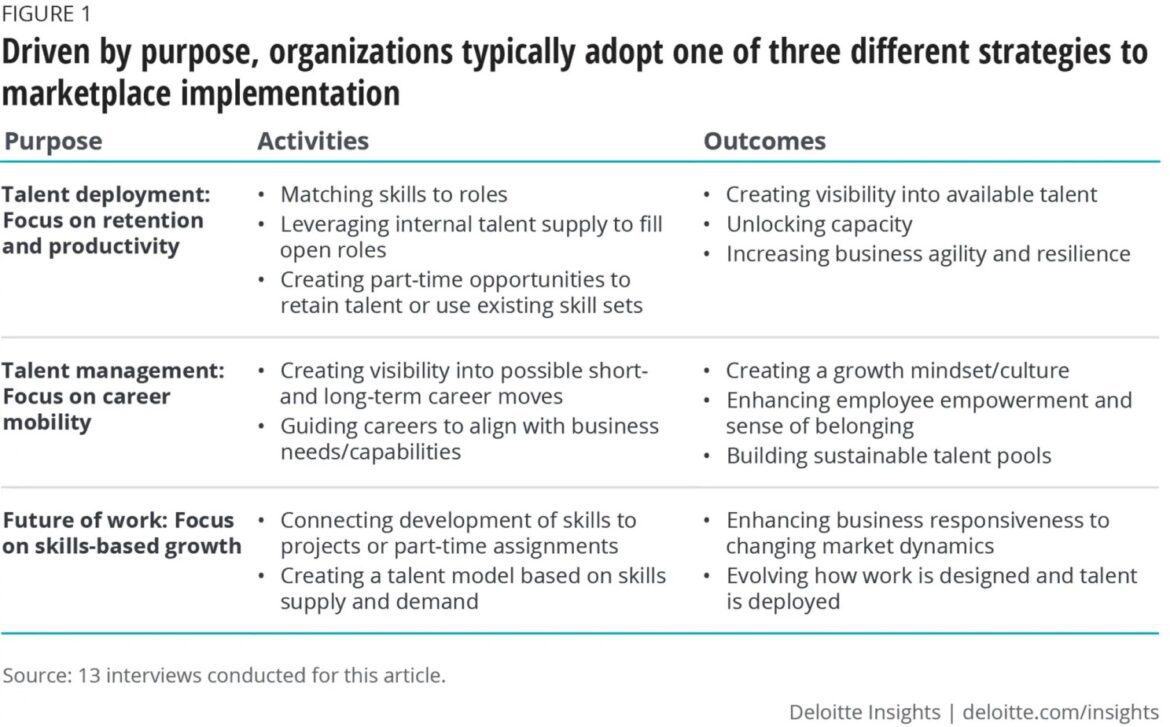
Why the Internal Talent Marketplaces are the Future of Talent Management?
today2022.05.26. 7390 1 5


Giorgia Calabria, Senior Talent Manager Benelux & HeForShe Lead at Danone
WHY SHOULD YOU CARE?
As a result of the current disruption and driven by the hot job market, companies are working hard to improve internal development opportunities and internal mobility programs. In this context, the Talent Marketplace has become essential and the HR tech market is exploding with new solutions and platforms. As shared in my first article published a couple of months ago, the most “powerful weapon” that we have in Talent is supporting our internal employees and today, I would like to share how we could start this journey. I hope you find it interesting.
As shared in my first article, the most powerful tool we have in Talent is managing our internal talent pools and in the last years, top-notch companies have been working hard to improve their internal mobility strategies and to find a more human-centric approach that can help them improve the sense of engagement of their employees, especially during the pandemic.
We have all read several studies about the internal talent marketplaces and we have seen some inspiring best practices implemented in top international companies like Unilever and Schneider Electric – do we know where to begin?
To put it simply, we can define the Internal Talent Marketplace (ITM) as a two-sided platform that harnesses the power of AI to align employees and their skills to new opportunities and it is expected to provide them access to gig work, mentorship, rotation programs, stretch and volunteering assignments and innovation and skill-building experiences that align with business needs. There’s no denying that implementing a talent marketplace is a major change and we need to deep dive into the pros and cons that this talent strategy can bring inside our companies.
Let’s imagine that today, we are all sitting together building our first Internal Talent Marketplace it’s exciting, isn’t it? I feel like a modern Michelangelo who has in front of him a block of marble and who will create something magical, something unique, his David. We are artists who need to use their expertise and imagination to build something that will revolutionize our way of developing and supporting our internal talents.
Let’s start from the beginning. The Internal Talent Marketplace can have different stages as detailed by Josh Bersin who explains how the strategies evolve in three stages. We can have different stages linked to the internal Talent Marketplace and we can find a detailed recap in this research by Josh Bersin in which he is explaining how the strategies evolve in three stages.

Bersin said that one of the biggest benefits of the talent marketplace is that it allows career growth to be everyone’s responsibility, not just the manager’s job. “It makes people aware of opportunities in the company and matches people to those opportunities; creates connections between project managers and people looking to work on projects; fosters professional development; facilitates teams to get more work done.” I totally agree and based on my insight, the Agile Talent Mobility is the one from which we should start when we want to activate our Internal marketplaces and it’s the future of Talent Management.
When we are thinking of implementing this Talent Strategy, first, we must understand that to be successful, you need to be a sort of Giorgio Armani who is designing a dress for a very specific person and situation – you must customize it to better fit to your company’s culture and strategy. Talent Management needs to be influenced by your company’s strategy, but its strategy needs to be driven by the talent that is available to it and how it can be managed. It’s an interactive and agile design process and requires continuous transformation and your mantra should be this one “The real voyage of discovery consists, not in seeking new landscapes, but in having new eyes” (M. Proust).
The next step is to define the vision of our marketplace and I have found interesting this research by Deloitte (Irina Gantcheva, Robin Jones and Diana Kearns-Manolatos) in which you have the four ‘Ps’ project management approach (purpose, plan, program, and platform). Each of these steps is crucial and should be repeated cyclically to ensure that the strategy, change program, and enabling technology can continually evolve. So, the design around the four ‘Ps’ should be something like that:
· Purpose: Define the strategy based on what you would like to achieve and the impact that you want to bring
· Plan: Determine the iterative steps required to activate it
· Program: Define the policies and processes that enable talent and career mobility
· Platform: Adopt the technology that it’s also reflecting your internal IT ecosystem.
In this process, the key step is how we will define the purpose of our Internal Talent Marketplace, why do we want to implement this new way of working? In her article, Irina Gantcheva interviewed several organizations, and she has found out that they are/were adopting three distinct strategies and for me, something is missing.

For me, the best strategy should be something that it is embracing these 3 approaches. We should start from our Talent Management strategy (TD; TA; Upskills and Reskilling; etc.) assessing where we are today and where we would like to be in the future; running some gap analysis and what are the capabilities that we can buy, borrow, or develop; assess the available resources; understand how it will be possible to create projects/missions or part-time assignments and those options can support the business agenda. What I am trying to say, is that the approach that we are going to use should match where the company would like to go in the future, and it should be strongly connected to the business priorities to fully engage our senior stakeholders. The Internal Talent Marketplace is not an HR topic, it represents something bigger, and it should be considered as a sort of new business management model. We should see it much more than a platform to manage career path programs, and internal recruiting – it’s a dynamic ecosystem in which the employees are expected to take the initiative and the managers are responsible for creating the right dynamic environment. If today our leaders ask themselves and HR “How can we make better and smarter investments in people?” tomorrow the key question will be “How can we support people in making better, smarter investments in themselves?”. This is a cultural change and the new model for managing internal mobility is less focused on “careers” and “experiences and skills”.
Looking at Talent Management in our companies, adopting the Internal Talent Marketplace means that we also need to change our way of working, especially in TA, we must move from recruiting to employee upskilling and career coaching. We must create ad hoc training to equip our Recruiters/Talent Managers because their core business will not be filling vacancies but driving and supporting a more fluid talent market. I think that jobs will still exist (maybe we will not use ‘old fashioned’ job titles anymore) but the way we look at jobs needs to shift and in Talent, we need to help our business leaders and employees shift their mindset and move to a more skills-based approach.
Now that we have a clear purpose and a plan to activate it, we should look at which kind of resources we need. First, we should select the platform that we need, and Josh Bersin is offering again a nice recap of what the vendors’ market looks like.

Gloat with its platform InnerMobility is one of the most successful in the market. Their clients include Unilever, Schneider Electric, Seagate, ADP, and others.
In Danone, I have had the opportunity to use Avature for our external talent pipelines and I have found it highly configurable, and it lets you design workflows, business rules and reports your needs.
With implementing Talent Technologies, one of my biggest lessons has been that we don’t need the fanciest tool, we need the one that it’s matching with our tech maturity, that works well with our current tools, something that we will not change after 12 months wasting our time and money. On top of that, we need to create some internal Tech Talent roles that can offer internal support to the users and keep monitoring the evolution of the tech best practices. For sure, our plans can always change but let’s be smart in the way of investing our resources.
Now that we are almost ready to launch our strategy, we do not need to forget that “the devil is in the details” and for this reason, I have identified the benefits of implementing the ITM and some possible setbacks that we should check before finalising everything. Starting with the positive side, we can have 5 benefits that are strongly linked to the Future of Talent:
1. breaking down silos, the traditional rigid hierarchies and career paths are no longer valid in our fluid business contexts
2. unlocking agility, moving from a reactive to a proactive approach when we assess our talents and their capabilities
3. strategic upskilling and reskilling in which we take our Learning Portfolio to the next level by matching people to projects, gigs (short-term engagements that typically don’t involve a change in pay or job code), and mentorships that will provide the hands-on experience that was once lacking
4. bring a more diverse and inclusive approach removes bias from the equation and increases the visibilities of all our employees (not only the top potential ones)
5. increase engagement and retention support the development of our employees and open new opportunities that align with both their skills and ambitions as well as your business priorities.
Sounds like a no brainer? Before reading this and jumping into an ITM without a second thought, I want to share 3 considerations that must be addressed and approached in a special way, ignoring these could impact the success of your ITM.
1. One of the biggest barriers can be culture. We are used to seeing internal job changes as a risk and the hiring managers usually want someone with experience, maybe the internal candidate may not be ready and if they fail or underperform, they may not be able to get their old job back. The normal career path is based on comments like “you’re an HR person” or “You are a stellar Sales guru” and with that, it’s hard to reinvent your career. How do we support cross-functional moves? Do we have training tools available to help people rapidly learn new roles? So before implementing the Internal Marketplace, we should assess what we have in-house and if those tools are sufficient to support this strategy, if not, we need to be sure that first fix those gaps and prepare a strong culture that will promote and support this new Talent strategy.
2. To be sure that our strategy is inclusive and is considering all the talents in our companies, we need to tailor our strategy in a way that will offer opportunities that reflect the employees’ desires and needs. For example, you have a top professional in accounting who after 10 years in the same role, she doesn’t want to change job, but she is not fully satisfied, how we can keep her engaged? In this case, we should listen to her, to what is giving or draining her energy and map everything in her Talent Card. Maybe we will discover that she can be a great mentor for our junior talents, and we need to connect her to one of the mentoring opportunities available in our Marketplace.
3. Make opportunities reflecting what our employees would like to explore. For many talents, more skills without more opportunities are insufficient. If our employees don’t value the opportunities we are offering — if those don’t speak to their passion, potential, and purpose, for example — they can and will likely leave. So, let’s continue listening to what our employees are sharing with us, and let’s ‘bring the outside in’ in the way of designing those opportunities.
Something that you need to do to be successful in this journey, it’s to set clear KPIs for your Internal Talent Marketplace. How will you assess if your strategy is successful? What and how do you need to change or adapt? The strategy should have some clear short and long term KPIs to monitor and assess how you are doing, for example checking how many of those opportunities have been closed with internal talents, why an opportunity was not accepted, and running some ad panels to listen to the Business comments.
Now, if we think that our designing phase is strong enough we are ready to start the second part of the journey implementing your first ITM. If not, let’s review the process starting from the culture of our companies.
This new talent model has the vast potential to change our company’s culture, and the way how our companies think about work, the workforce, and the workplace. It’s a powerful tool so do not forget that “with great power comes great responsibility”.
I hope that I have been able to trigger your curiosity and appetite about the Internal Talent Marketplace and please feel free to reach out if you have questions or if simply you would like to brainstorm together.
Stay tuned!
#HR #Talent #FutureofHR #talentmanagement #talentmarketplace #development #hrtech #humanresources #recruitment #recruiting #recruitingtrends #talenttrends #HRtrends #InternalTalent #InternalTalentMarketplace #Avature #Gloat #Workday #ibm #JoshBersin #Deloitte
Written by: Giorgia Calabria
Future of Work HR Strategy Talent Talent Management
Previous post

- 249
- 1
labelPast Events today2022.05.25.
Performance@Work – From Performance Management to Performance Enablement.
Underwriter: betterworks Watch the forum on demand. Recorded on 24th May, 2022. The HR Congress Forum presents:Performance@Work – From Performance Management to Performance Enablement The days of yearly performance reviews [...]
Similar posts

labelArticles today2024.10.21.
The success-recipe to build agile and future-ready organizations in 2025 and beyond







Post comments (0)